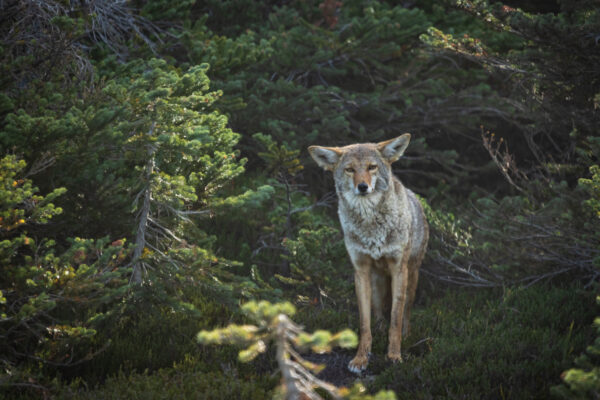Whistler Nature Camp Diaries
Read through some of our fun weekly blog posts to get the insider’s scoop on our session adventures!

Our final week of nature camp is unfortunately upon us. While we’ve had a summer packed full of fun and adventure, we still found a way to squeeze just a bit more in before we said goodbye to our campers until our Pro-D days.
Our ultimate theme was Trees Please, and we had no shortage of possibilities for exploration as we looked at the entire flora our forest had to offer. We first decided to investigate the mysterious mushrooms of all different shapes and sizes that have been popping up throughout the forest for the past number of weeks. Our budding biologists grabbed their nature journals and headed for the hills to spot and describe as many different species of fungi that they could. We unfortunately didn’t have time to brush up on our Latin species names so we decided to rename them ourselves. Our most exotic looking ones were the T-Rex mushroom, the fried egg mushroom, and of course, who could forget, the pancake mushroom!

A cause for excitement was the discovery of a new magical huckleberry forest, which was just as well because supplies at our previous patch were running worryingly low. We gathered enough berries to feed a small army, although thankfully we didn’t have to, as the rations rarely made it back as far as camp.
We learned to age trees this week, and what different patterns of rings might mean on a stump. We also looked at how we would detect a flood, a drought or a forest fire that happened in the past just by studying those rings. We went on some of the paths less travelled and hunted for the biggest oldest looking trees that we could find. We had fun guessing the age of trees by seeing how many people it took to hug it! (also discussed was the difference between being 100 years old and 1,000,000 years old).
A huge thank you to our final group of summer campers for making this week such a roaring success. We’d like to take this chance to sincerely thank everyone who has joined our nature camp family this summer as well as those of you who continue to support us and make all of this possible. We wish our campers all the luck in the world for their upcoming academic years and we hope to see all of you at our upcoming Pro-D days and of course our spring break camp next year.
Kind Regards,
Kristen, Mia, Janelle and Kieran.

A little birdie told me this week at Nature Camp it was Winged Things! Our campers got to learn all about what mysterious and beautiful birds, mammals and insects get to fly above us each and every day. From damselflies and backyard crickets, to the rulers of the sky during the day and night, our campers got to investigate what and how these cool creatures get to darting around us. Let’s get our eagle eyes out and look at what they got up to this week!
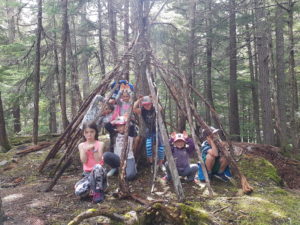
We started our week looking at the local birds we find in Whistler and identifying their bird calls. Naturally our flock were able to identify the call of a Chickadee and were quick to mimic it whilst out on our nature walks. Eagles, Grouse, Hummingbirds and the Pileated Woodpecker also made a surprise appearance with their unique calls. The next day we asked our campers to tell us their favourite flying thing and to combine it with another favourite animal. With their combined creative minds we invented quite a few new species. Look out on your walks around Whistler for Chick-a-pus (Chickadee Platypus), Nargle (Narwhal Eagle) and Buttougar (Butterfly Cougar). We also took a good look at the ruler of the sky, the majestic Bald Eagle, as well as everyone’s favorite mosquito hunter, Bats! Did you know that bats are mammals and can eat up to 600 mosquitoes in one night? Or did you know that when a Bald Eagle feels like some light reading it can read a magazine up to 91 meters away? Our Campers sure do!
With so much knowledge up their sleeves, we put our campers to the test during our nature walks. Eagle eyes were a must have in order to see a quick darting Pika and a hunting Heron on the way back from Green Lake, a magical huckleberry forest, a territorial Stella Jay, and Grasshopper catching right in our backyard! We also honed our hiding and looking skills at our local Pirate Ship in games of Camouflage and Eagles Nest. With some tiring birds throughout the week, it was lucky we had made some real nests for our campers to rest up in! With both nests having to be able to hold up to 6 campers, everyone had to work really hard collecting sticks, pinecones, rocks and leaves to provide a safe nest. Luckily our birdies had evolved to have two hands and not just beaks to collect the goods! On one walk a lucky camper got to see a Lime Hawk Moth Caterpillar crossing the valley trail. We further investigated and realised Moth Caterpillars and adult Moth’s have the most amazing wing patterns! We used this inspiration to test out our campers the next day with a mixture of real and fake photos. Who knew an Owl face existed on the wings of a moth?!
As usually we wrapped up each day this week with a fun craft activity. Our campers got to make everything from individual old man’s beard nests to hanging bats, hand and feet Bald Eagles and Bird’s Masks. We had such a fun time learning, exploring and creating all about Winged Things at Nature Camp this week and we hope our Chickadee Campers did too!

After the long weekend we returned to camp well rested and raring to go. We had campers from as far away as Mexico and Hong Kong and we were glad to greet them with some warm Canadian welcomes as we embarked on our wetland adventures.
Our Wild Wetlands week coincided perfectly with the peak of the Western toad migration at Lost Lake. As the tiny toadlets undertake their mammoth migration between the lake and the forest they provide an exciting opportunity for people to observe and marvel at animal instincts live in action.
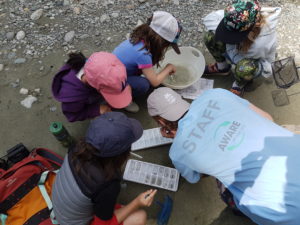
We started off the week in scintillating 30° style. It was the perfect day for some of us to set off to lost lake. While the beach was closed, we were still able to assist in some toad transportation. We put on our gloves and got our tubs ready (our campers will be able to tell you how harmful our skin’s oils can be to the toads), and helped them across busy pathways. Our wanderers also turned wardens as we were sure to inform bikers and hikers of the threat they posed to our toads on the trail ahead!When we got back we reenacted our lifesaving heroics and created jumping origami toads!
Throughout the rest of the week our hikes included visits to the ‘Toads of The Short Forest’ wetland, Fitzsimmons Creek, and the White Gold Traverse. While down at the river we found some squirming stonefly larvae as well as some creative caddisfly larvae, who make a shell for themselves from nothing more than sand, stones and a bit of saliva! Of course for anyone who had had their fill of bugs, mud pie was also on the menu at our 5 star creekside kitchen.
We also revisited the river to float our boats, that we had fashioned from some twigs and string, not to mention a few homemade pirate flags. While some ships were still finding their sea legs, we still learned some valuable lessons; like rocks make for a heavy cargo load!
Back on dry land, we got to do some scavenger hunts on the trails, where we spotted squirrels, counted some crows and scaled some slopes. When it turned to craft o’clock, finger weaved snakes were the order of the day. Our campers learned to weave many animals using nothing more than some yarn and their two hands!
All in all we had a fantastic week and we hope our nature campers did too. We hope to see many of you for our final two weeks of camp, and to those of you who have returned to homes further afield, we hope to see you here again next year!

Week 5 of Whistler Nature Camp is over and our campers are officially predators and prey in their own right. Don’t be surprised if you lose your camper whilst out walking, they are now officially better than a Snowshoe Hare in the middle of winter at camouflaging themselves!
During our nature walks this week, our campers honed into their inner predator mode to find the best, worst and weirdest animals in the forest. Garter snakes were high on the menu for our feisty pack of wolves. Each day a new sighting showed our pack how prepared these slippery ‘Snakerson’ are for staying away from their airborne prey. Luckily our pack was the strongest in the forest and we were able to snatch up one each day. A couple of our team noticed quickly that a defence mechanism of the Garter Snake is to let off a foul smelling pee, but that didn’t stop our pack from being still curious. Our pack also had to keep in mind that, while we’re the strongest out there, there are still challenges we have to face. On most days a local volcano must have exploded because more often than not the floor had turned to larva. Working as a team we had to use any means possible to get back home!
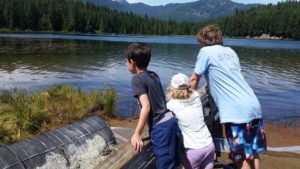
Turning off our predator mode for a day, our group took a hike down to Lost Lake to see the Tiny Toad migration. These little guys got a big helping (gloved) hand to make their way from the lake to the forest and they sure appreciated the protection we gave them! On most walks our groups also decided we needed to use some of our own predatory skills so Nature Parkour and Nature Ninja Warrior were big hits, showcasing our speed, strength and agility.
At the end of each day, after successfully catching our food (berries) or staying hidden from our prey, our campers got creative by building homes for their animal friends and decking their own homes out with nature photo frames and jewelry, as well as finger knitting some toy snakes to cuddle at night. After a big day out exploring we all need our little luxuries, but for now our Nature Camp pack are taking a well deserved long rest. Until next week campers!

We’ve had another wonderful week here at AWARE Nature Camp, packed full of adventure, curiosity and creativity. This week our campers were tasked with becoming fearless wilderness survivors as we prepared ourselves for situations which left us foraging for food, scrambling for shelter and hankering for hydration.
What would you do if you found yourself in Whistler and you had no food, no water and no roof over your head? This is the question we asked our survivors on day one, they were quick to tell us that they would take to the forests to build shelters, where they could keep all the food and water that they had gathered. They knew they’d have to be crafty to conjure up food and water, but they assured us that they had the fort building expertise to see them through the stormiest situations imaginable.
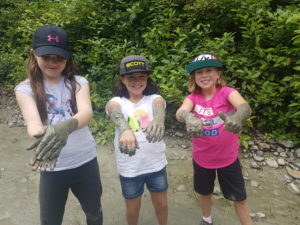
Food seemed to be the first (and the second) thing on everyone’s mind, so we found our nearest berry patch where we gathered thimbleberries, blackberries, wild blueberries as well as black and red huckleberries. We found out that we could store them all in berry pouches made from gigantic thimbleberry leaves. We also learned that the same thimbleberry leaves have gained a reputation as being ‘nature’s toilet paper’…although we made it back to base before we had to test that one out. For our main course we made ourselves some fishing rods from fallen branches and headed down to the river. We used some wool as fishing line and a pipe cleaner hook (that we decided mother nature would so kindly have provided for us in our survival situation). The fish weren’t biting on this occasion but we have no doubt our budding fisherfolk will have more luck on a different day.
Our explorers were natural fort builders, and it was just as well we were all in survival mode, as we spotted a black bear rooting around for some supplies of his own in some forest in the distance. We were all on the ball though as we came together and made ourselves look big. For some reason the bear wasn’t that interested in our super structures, oh well, his loss, he continued on his merry way! We took great pride in our forts and the reinforcements and decorations had to be kept up on nearly a daily basis all week, but our hard work was rewarded and they turned out great. When we weren’t busy building we made some string telephones so we could stay in contact from fort to fort. The service was hit and miss, but hey, not bad for the middle of the forest right?
Gathering water proved trickiest on these (finally) warmer, drier days. Our campers made ‘Summer Coolers’ by wrapping a plastic bag around a branch and collecting the transpiring water the leaves would produce some hours later. We also knew which water sources around the village would be the most reliable, and talked about how we would filter dirty water if we needed to. For now however, we were happy enough to come home and fill our water bottles from the tap!
When we had all the necessities taken care of, we found some time to take a walk out to lost lake. We tracked the progress of the tadpoles and toads undergoing their great migration, and gave them some words of wisdom and encouragement. While we were down there we made ourselves some binoculars from old toilet paper tubes, and observed the surrounding wildlife, which included chipmunks, squirrels and Stellar’s Jay! While on other walks during the week we made some nature portraits from lichen, leaves and whatever was lying around; we had some uncanny resemblances of creepy caterpillars, beaky birds and even some cheery camp leaders.
A massive thank you to everyone who owed to this week being such a huge success, we hope to see you all again over the rest of the summer!
 This week we looked at all things creepy and crawly. We learned why those tiny guys are so important to us bigger critters, from pollinating our fruits and vegetables, to being a valuable food source for everything from bats, bears and many things in between. We delved into habitats and found out why bugs live where they do; while living underneath a damp dark rock may not sound cosy to our campers, we found that it provides an ideal home for many different species. When we were out bug hunting, lifting rocks was the easiest and best way to spy on our small friends. Of course we always remembered to put the ‘roofs’ back on the critter caves that we disturbed.
This week we looked at all things creepy and crawly. We learned why those tiny guys are so important to us bigger critters, from pollinating our fruits and vegetables, to being a valuable food source for everything from bats, bears and many things in between. We delved into habitats and found out why bugs live where they do; while living underneath a damp dark rock may not sound cosy to our campers, we found that it provides an ideal home for many different species. When we were out bug hunting, lifting rocks was the easiest and best way to spy on our small friends. Of course we always remembered to put the ‘roofs’ back on the critter caves that we disturbed.
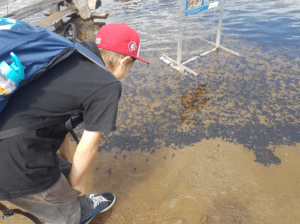
On our hikes this week we covered a lot of ground. None of which passed without a highlight for our adventurers. We found a gargantuan garter snake, who was more than happy to let us hold him for a few minutes (until he grew bored of us)! We were also lucky enough to catch the very first stages of the Western toad migration, down at lost lake. We saw tens of thousands of teeny tiny tadpoles start to prepare themselves for the epic journey ahead. Our troopers turned into trappers as we set pitfall traps in the forest to try and lure in unsuspecting insects with some fruit as a reward. While we were setting our traps we also found a few ant colonies, who were not about to fall for our tricks! Once we had conquered the land, we set our sights on the water as we caught and identified some dragonfly, damselfly and caddisfly larvae on the waters edge, using nets and our quick reflexes!
We had lots of fun and played games inside and out, including plenty of games of predator and prey while we were out exploring. We even found time to build some insect hotels in the shade of the Wooly Mammoth. In the ‘Cr’afternoon, when our hiking legs had grown tired, we sat down to put our hands to work using materials we had gathered during our morning activities. Among our works of art our mini Michaelangelos created some symmetrical butterfly prints using paint, some spooky spider webs using yarn and sticks, and of course some nature portraits. We hope every camper enjoyed their days of adventure and exploring as much as we did!

This week in fancy flora our nature campers were exploring all things plants! Our mornings started off with sharing experience and knowledge of local edible and wild plants. Berries were the first item on the menu! We learned about what berries can be found in Whistler, as well as what animals rely on them as a staple food. We touched on the science of photosynthesis and why it makes some plants green, as well as the different roles roots, stem and leaves play. Some campers got to witness some very busy honey bees, bumble bees and wasps searching for food and were lucky to see how plants rely on these amazing insects to pollinate!
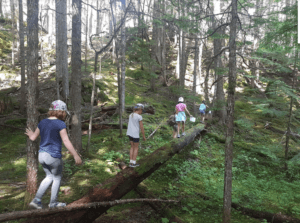
Every day, rain or sunshine, our campers got out for our nature walks! Starting on our local trails our campers had an amazing berry hunt! Fear not the stomach ache, for our campers quickly became experts at identifying thimble berry, native blackberry, blue & black buckleberry, blueberries and strawberries. A quick harvest of some native ginger growing on the side of the trail provided a yummy afternoon tea, whilst stories of the old Douglas Fir and Hemlock tree were shared.
Lost Lake was visited at the end of the week and our campers saw thousands of tadpoles in the shallows! We were also very lucky to see two Garter Snakes having a quick bite to eat (of the tad poles) before we decided to create some crafts to cross the wild sea of Lost Lake (if we were the size of a toad).
Our nature campers had such a busy week learning and in between we had some great times including playing mosquito, bear & salmon, building a nature fort and painting a welcome sign and decorations. A few times this week a local volcano must have erupted and our campers had to find creative ways not to touch the lava (ground). Whilst visiting some river plants we cooked up a storm and served some yummy mud pies!

Each morning this week, we started our day off with a few name games to help us get to know one another. Our campers also shared their experiences in nature, and our Whistler natives were able to tell our travelling friends about what they might expect to see here. We touched on what biodiversity was and talked about the importance of conserving the habitats of every single species in our ecosystem. Our campers already knew so many of the species that call Whistler home, like the beaver. We were lucky enough to be able to handle a real beaver pelt, and we could hardly believe how soft it was, not to mention that an area the size of our thumb on the beavers back contains more hair than a person’s entire head!
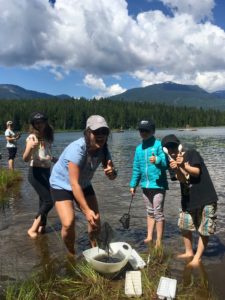
Our daily nature walks in the nearby trails let us experience so much of our surroundings, first hand. Along the way, we found so many animal habitats. Even if we couldn’t see the animal, we learned how to read signs there may be one in the area; a chewed log, a hole in a tree trunk, a dead branch on the forest floor, are all examples we can link to specific animal homes. Luckily, getting hungry along the way wasn’t a problem, our campers are now experts at determining which berries are the tastiest and also which ones to stay away from altogether. We learned that some plants have awesome adaptations like sap, to protect themselves from hungry herbivores. We loved discovering that sap can also be used to create super speed boats by putting it on the end of a twig – racers really enjoyed that one!
Occasionally after a nature walk, we decide to sail the seven seas by stopping at the pirate ship for some grrrrrreat games and some free exploration time. We kept busy on the way to and from home as we played Salamander Says, Eagle’s Nest, and we even had time for a round of Nature Bingo. In our ‘Crafternoons’, we let our imaginations run wild as we created habitats to mimic what we had seen throughout the week and using materials that we had collected from our surroundings. The gnarly nature journals made by campers will be excellent companions for the budding biologists to track their activities throughout the sensational summer which lies ahead!




